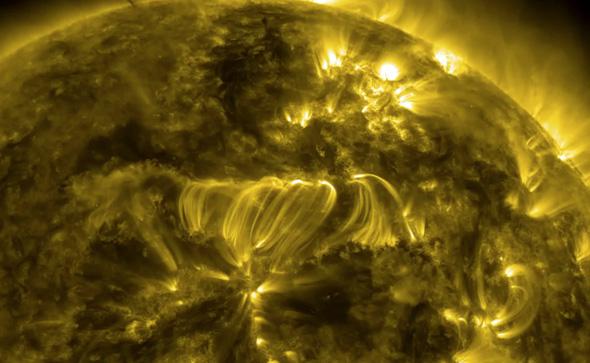On the last days of September 2013, the Sun gave us a powerful reminder that it is still indeed a vast source of incomprehensible energy and power. On Sep. 29, an enormous, towering loop of material erupted from its surface, quickly arcing up and away from the Sun. Megatons of superheated gas, called plasma, blasted away from the Sun, leaving behind intense, tightly coiled magnetic field lines, with gas streaming around them at high speed.
And all of it was captured by NASA Solar Dynamics Observatory (SDO). The video below shows it at multiple ultraviolet wavelengths, each giving us insight into the huge energies at play.
The explosion itself is called an eruptive filament. To give you a sense of scale, it’s well over 300,000 kilometers (200,000 miles) across; about the distance from the Earth to the Moon. It’s caused when huge loops of magnetic field lines get tangled up. These magnetic loops are similar to those of a bar magnetic, but much, much more powerful. They come from below the surface, generated by rising packets of heated plasma bigger than planets. As the loops pierce the solar surface, they interact with the plasma there, creating sunspots and twisting ribbons of material. As they move around they get entangled and can suddenly snap, releasing their energy.
The power of the explosion is staggering, dwarfing our entire planet’s nuclear arsenal into insignificance. Tens and even hundreds of millions of tons of hydrogen is blasted into space, most of it leaving forever, some of it trickling back down along those same magnetic field lines.
What’s left behind are more tightly-coiled spirals of magnetic field lines, hot plasma still able to whip around them. The impact on the surface is profound as well; what looks like a widening canyon of hot material splits away. What you’re actually seeing are two ribbons of material moving in opposite directions, marking the location of the magnetic footprints of the eruptive event.
This event was also tied to a coronal mass ejection; the material lifted up and away was completely ejected from the Sun. It traveled across the inner solar system, impacting the Earth, and triggering lovely aurorae across the northern latitudes. The physics behind this is pretty interesting, as the subatomic particles are funneled into our atmosphere by the Earth’s magnetic field, causing our air to glow.
The Sun’s magnetic activity waxes and wanes over an 11 year cycle, and we are near or at the current peak. It’s been very weak, and only time will tell how tempestuous our neighborhood star will be over the next year or two. No matter what, though, SDO will continue gazing at it, and our knowledge of the Sun will only increase.
